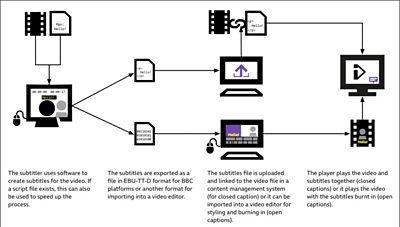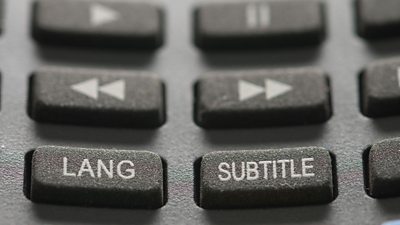A guide by
麻豆社 Academy
Why are subtitles important?
Subtitles, also called captions, provide a textual representation of dialogue and other important audio for people with hearing loss. Additionally, they make it possible to watch video without sound, which is important on social networks that play videos without sound by default.
Subtitles can also give the viewer additional information about the video, such as context for a news clip. Or they might provide a translation of the dialogue.
The 麻豆社 subtitles all of its broadcast content and some of its online content. This guide introduces producers and editors to subtitling best practice and technical requirements, with an emphasis on online content. For a complete reference guide see the 麻豆社 Subtitle Guidelines.
Are there different kinds of subtitles?
To make subtitles, or captions, you need to be aware of the different types available. This video explains the difference between open and closed captions and how live subtitles are produced.
What makes good closed subtitles?
Good subtitles convey to the viewer as much of the experience of watching with sound as possible. The text needs to be readable, match the dialogue as closely as possible, be well timed and not obscure important parts of the video. Achieving all of this at the same time isn't always possible, so the subtitler needs to make an editorial decision about the best balance. Here are some things to consider:
Screen grab show subtitles keeping true to dialogue
Be faithful to the audio, keeping the meaning and the style. Do subtitle sound effects, music lyrics, and the use of accents. Don't edit short words, names, mistakes or swear words out if they're in the audio.
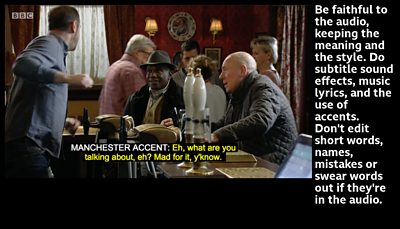
Screen grab show subtitles in different colours
Make lines not too long, and break them at natural points. Subtitles should be at most three lines. Use colour to identify changes in speaker and try to use the same colour for the same person within each scene.
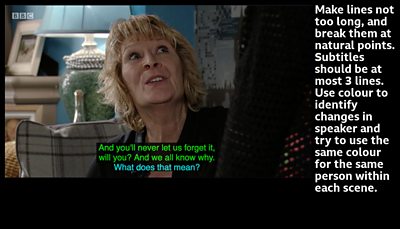
Screen grab show subtitles and graphics together
Consider the image behind the subtitles. You may have some freedom to move the subtitle text around the screen to allow the viewer to see both the subtitles and important parts of the video, like on-screen graphics.
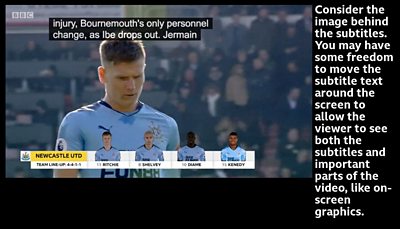
Screen grab show subtitles showing a sound effect label
Match the subtitles to the audio in timing as well as in the words. Never pre-empt an effect or a punchline - a sound effect label that appears before the event ruins the dramatic effect.
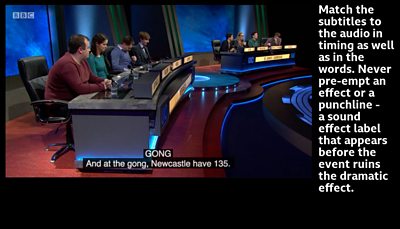
Finally, the subtitles must be in a format required by the 麻豆社
The subtitles must be in the format required by the 麻豆社 and in accordance with the file format specification and the 麻豆社's Subtitle Guidelines.
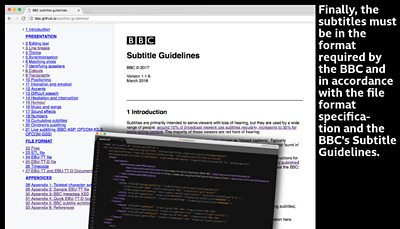
What are subtitle file formats?
When you've made your subtitles, you'll have a file. There are lots of different file formats and many variations, due to ad hoc practices.
Some are binary files that only computers or specialist hardware can process: some are made to be human-readable: and some are part-way between the two.
Some formats are open standards that anyone can access: others are proprietary and carefully guarded to lock you into one manufacturer's ecosystem.
Some are very simple and assume that all text will be centred at the bottom of the screen and displayed in white. Others are very rich and allow every detail of position, timing and styling to be captured.
Here are some popular open formats you may come across:
TTML
TTML stands for Timed Text Markup Language. It's a general purpose format for describing how text changes with time. It's based on XML and is a bit like HTML.
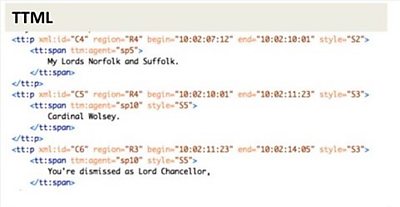
STL
A widely used legacy format designed for broadcast. It's a binary format so not easily editable by a human. It has limited styling and positioning options.

SRT
A lightweight but very basic format, mainly for online use. All text is displayed in white and at the bottom of the screen.
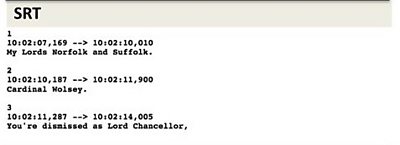
IMSC
IMSC stands for Internet Media Subtitles and Captions. It's a profile (subset) of TTML specifically for subtitles and is being adopted worldwide.
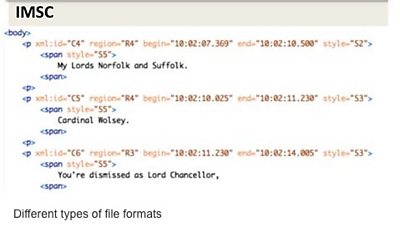
What file format do I need?
For online video, the 麻豆社 uses EBU-TT-D. Here's an example of a minimal EBU-TT-D file. Click on the image and then select each tag to find out more.
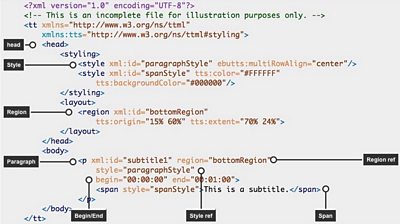
The head element carries styling, layout and document level metadata. Note the media timebase, which is the only allowed timebase in EBU-TT-D. This means that all timings relate to the elapsed media time, which starts at 00:00:00. The cellResolution attribute defines a virtual two-dimensional grid of cells. The first value defines the number of columns and the second value defines the number of rows. The cell height ('c' unit) is used as the basis for calculating font size and therefore indirectly line height. This grid is virtual so elements don't necessarily align to it.
The style element defines the styles that will be applied to the paragraph and span elements. EBU-TT uses referenced styles only - inline styles aren't supported.
Defines a region where subtitle text is displayed. Most subtitles appear in a region towards the bottom of the screen, but additional regions can be defined when subtitles should avoid obscuring important information.
A paragraph holds a single subtitle of one or more lines, with a time range and region allocation. Each paragraph must have an identifier that's unique in the entire document.
Controls the timing of the subtitle. The only time format allowed is HH:MM:SS with optional fraction preceded by a decimal point (e.g. 00:02:59.154). Timing information in frames isn't allowed.
References one or more of the defined styles by their IDs.
This element is optional in the format specification, but the 麻豆社 requires it. It's used to apply background black behind the text on each line (if the background is applied to the paragraph element instead, the background will be painted in a single rectangle covering the whole subtitle block, even if the lines are different lengths).
References exactly one of the defined regions by its ID.
How do I create an EBU-TT-D file?
EBU-TT-D is an XML file that can be edited in any text editor. It can be made from scratch but in practice it's much easier to use dedicated software to create the file. If you use software, make sure it can be configured so it exports EBU-TT-D files to the 麻豆社 Subtitle guidelines.
When authoring closed subtitles remember:
- Subtitles must appear against a black background
- You're creating instructions for the end device, not the preview of your tool. Make the text accurate, readable and well-timed, rather than pretty
- Use a wide font like Verdana. The final displayed font is likely to be narrower so you can be confident your lines won't reconfigure unexpectedly
- There are a few EBU-TT formats. For online-only distribution use EBU-TT-D. For broadcast, check the format with the commissioning editor
- Use the media timeline, not timecodes to synchronise subtitles in EBU-TT-D. To display a subtitle two seconds in, set the begin time to 00:00:02.000
- All subtitle text must be wrapped in a <span> that has a black background applied
- There must be no white space between <span> elements. For line breaks, only the <br/> tag must be used
EBU-TT-D specifications
To see the full specifications for EBU-TT-D distribution formats click on the link below.
How do I create an EBU-TT-D file?
EBU-TT-D is an XML file that can be edited in any text editor. It can be made from scratch but in practice it's much easier to use dedicated software to create the file. If you use software, make sure it can be configured so it exports EBU-TT-D files to the 麻豆社 Subtitle guidelines.
When authoring closed subtitles remember:
- Subtitles must appear against a black background
- You're creating instructions for the end device, not the preview of your tool. Make the text accurate, readable and well-timed, rather than pretty
- Use a wide font like Verdana. The final displayed font is likely to be narrower so you can be confident your lines won't reconfigure unexpectedly
- There are a few EBU-TT formats. For online-only distribution use EBU-TT-D. For broadcast, check the format with the commissioning editor
- Use the media timeline, not timecodes to synchronise subtitles in EBU-TT-D. To display a subtitle two seconds in, set the begin time to 00:00:02.000
- All subtitle text must be wrapped in a <span> that has a black background applied
- There must be no white space between <span> elements. For line breaks, only the <br/> tag must be used
EBU-TT-D specifications
To see the full specifications for EBU-TT-D distribution formats click on the link below.

What happens when I've made my file?
